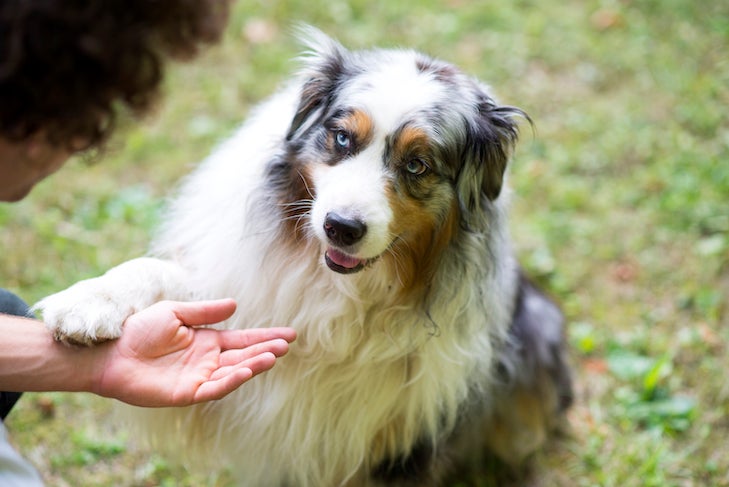
Your dog gazes at you with love and longing. Suddenly, you feel your arm or leg gently caressed by their paw. You may be wondering, why does my dog put his paw on me? Is it a sign of hand-holding canine style? Or, perhaps they want a treat, a few pats on the head, some attention, or maybe a trip outside for playtime or a potty break.
“When your dog puts a paw on you, it is most often a sign of communication, and it doesn’t always mean the same thing,” says Dr. Mary Burch, Ph.D., a certified applied animal behaviorist and AKC’s Director of the Family Dog Program.
What does putting a foot on your foot, hand, leg, or lap mean precisely? Like other ways your dog tries to get a message across, placing a paw on you can signal a few different things. “Dogs use body language to mean, ‘I have a need, such as ‘I need to go outside,’ or ‘I am hungry—it’s time for my dinner,'” Burch says.
Talk to the Paw
Whatever the reason, the connection with your canine is real. Dogs want instant gratification, and waiting until you’re ready to determine the exact meaning doesn’t always sit well with a dog. Although it’s easy to wonder what your dog wants, making coat-to-skin contact is a natural behavior for dogs. “Think about when a human hugs another person,” Burch says. “It can mean, ‘I love you,’ ‘I’m so sorry for your loss,’ or ‘I am so glad to see you again.’ ”
The canine touch also serves as a way to initiate communication. Think of the times you’ve begun a conversation by saying, “Uh,” or “But,” or raising your hand in a formal group setting. Dogs use a foot to bridge the communication gap. Your dog quickly learns that handing you their paw receives a positive reaction.
By giving you their paw, oftentimes, they just want a pet. “When I think of my dogs that would put a paw on me, my Border Collie, Laddie, comes to mind,” Burch recalls. “He would prompt me to pet him. And if I stopped, the paw would come down on my arm again.”

Applied behavior analysts call this “manding.” It means a request or a demand, and Laddie would do both depending on whether or not she responded, according to Burch.
However, there are a variety of requests your dog is asking for that can come from a touch of the paw—aside from you training them to “give you paw.”
They’re Hungry
Owners often respond to a paw by giving their dogs food—treats, leftovers from the table, or feeding their dog a meal. Food means love in any language and if owners don’t know why their dog is pawing them excessively, giving a tasty tidbit is an easy and quick fix. However, by doing this you may unintentionally cause the undesired behavior of frequent paw taps.
Some dogs could just as quickly bark for their supper rather than put a paw on your lap, but this might not produce the reward of food. Once a dog realizes no good comes from barking, placing a paw on your body might be their next alternative tool to try.
They Need to Go Outside
A puppy who wants to go outside for a potty break or playtime will try engaging you with pawing, barking, wagging a tail, or grabbing a toy and dropping it in your lap. If the paw doesn’t motivate you to move to the great outdoors, the dog may resort to putting its head on your lap and staring at you directly.
Putting a paw on you seems the least intrusive method.
They Want Attention
Some dogs are more independent and may never put their toes on you to offer to pet and to gain your attention. Other dogs are needier and crave your touch, so they’ll do it repeatedly. As mentioned before, pawing could just be a request for lots and lots of pets.

They’re Anxious
A paw on you may also mean that your dog feels worried. The roar of thunder, separation anxiety if they think you’re about to leave, or a sudden knock on the door, can frighten a dog and send it pawing at you for comfort. Heavy breathing, a low tail, or uneasiness may accompany your dog’s paw position. You can ease the concern with verbal reassurance that everything is OK, petting, giving a treasured toy, and mostly understanding that they need some comfort.
They Want to Comfort You
Dogs are highly perceptive creatures, and many can sense when their owners are feeling sad, lonely, or disappointed. If you’re feeling any of these emotions, they may try to cheer you up by pawing at your hands or feet to give you extra love.
By understanding why a dog puts a paw on you, you’re able to build a bond with your dog or strengthen the one you have, so don’t push it away always.

